Social Psychology in Organization
VerifiedAdded on 2022/11/29
|9
|1949
|94
AI Summary
This document discusses the role of social psychology in organizations and how it analyzes individual behavior and interpersonal interaction. It explores different types of organizations and their stages of growth. The document also explains the concept of business models and their importance in commercial and non-profit organizations.
Contribute Materials
Your contribution can guide someone’s learning journey. Share your
documents today.
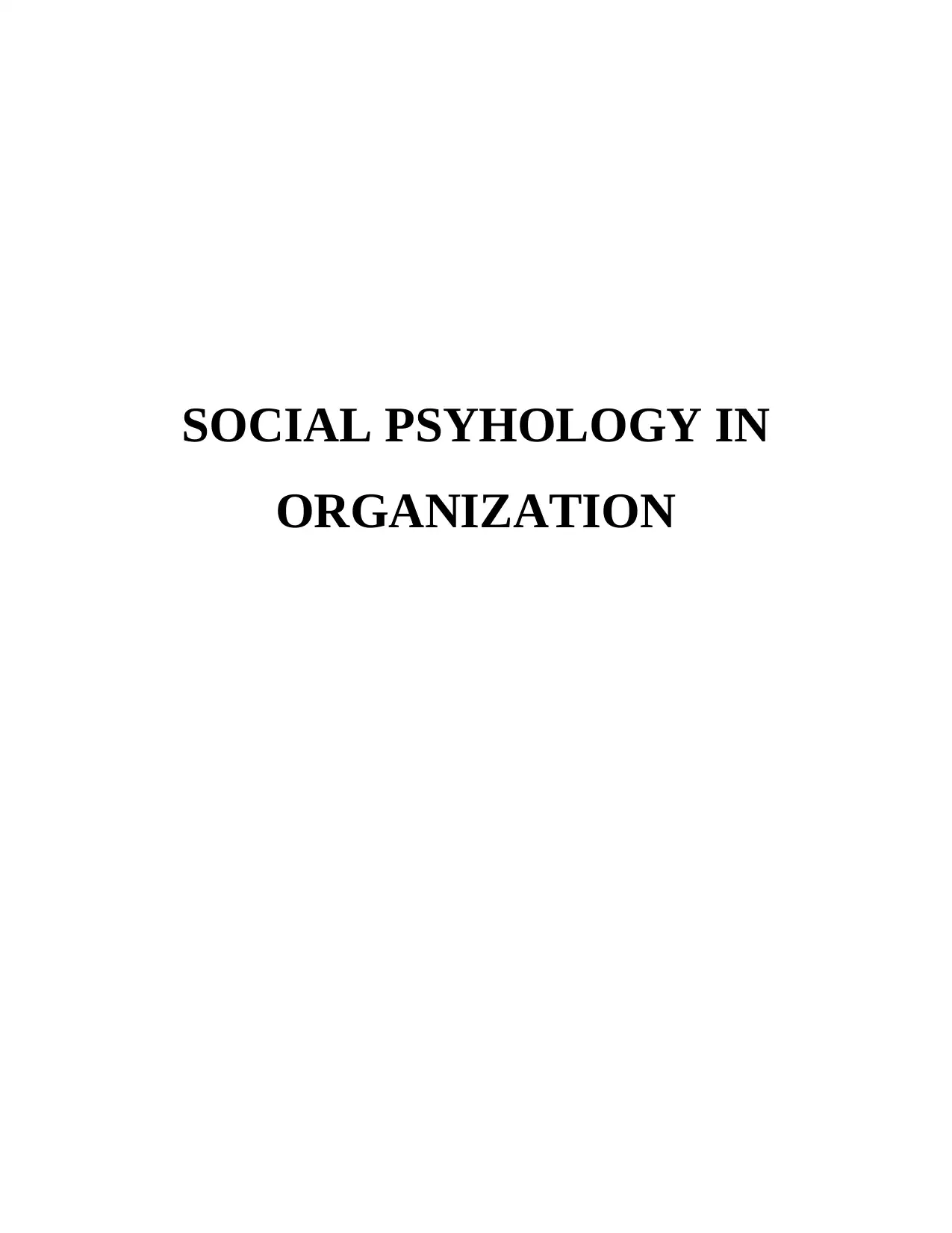
SOCIAL PSYHOLOGY IN
ORGANIZATION
ORGANIZATION
Secure Best Marks with AI Grader
Need help grading? Try our AI Grader for instant feedback on your assignments.
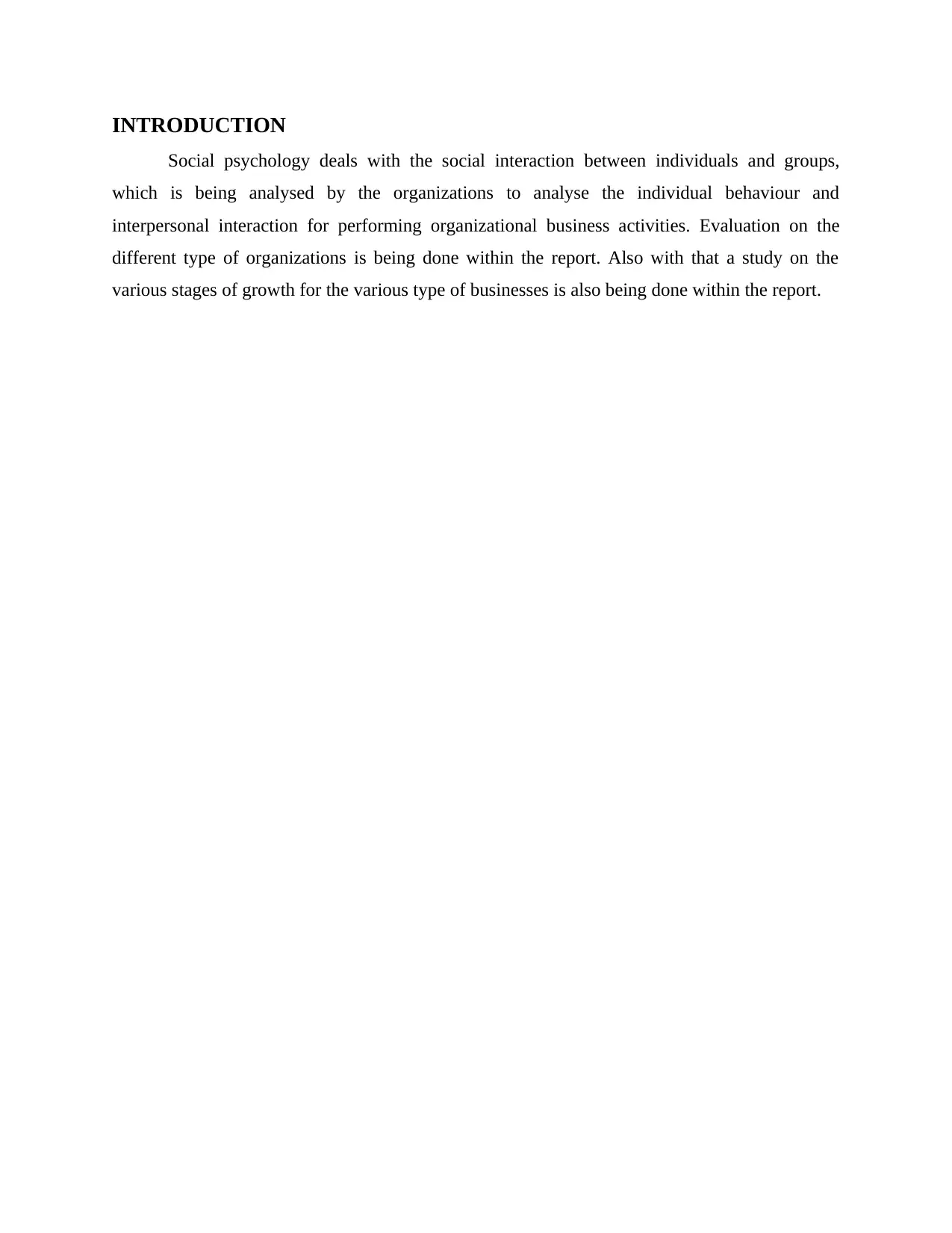
INTRODUCTION
Social psychology deals with the social interaction between individuals and groups,
which is being analysed by the organizations to analyse the individual behaviour and
interpersonal interaction for performing organizational business activities. Evaluation on the
different type of organizations is being done within the report. Also with that a study on the
various stages of growth for the various type of businesses is also being done within the report.
Social psychology deals with the social interaction between individuals and groups,
which is being analysed by the organizations to analyse the individual behaviour and
interpersonal interaction for performing organizational business activities. Evaluation on the
different type of organizations is being done within the report. Also with that a study on the
various stages of growth for the various type of businesses is also being done within the report.
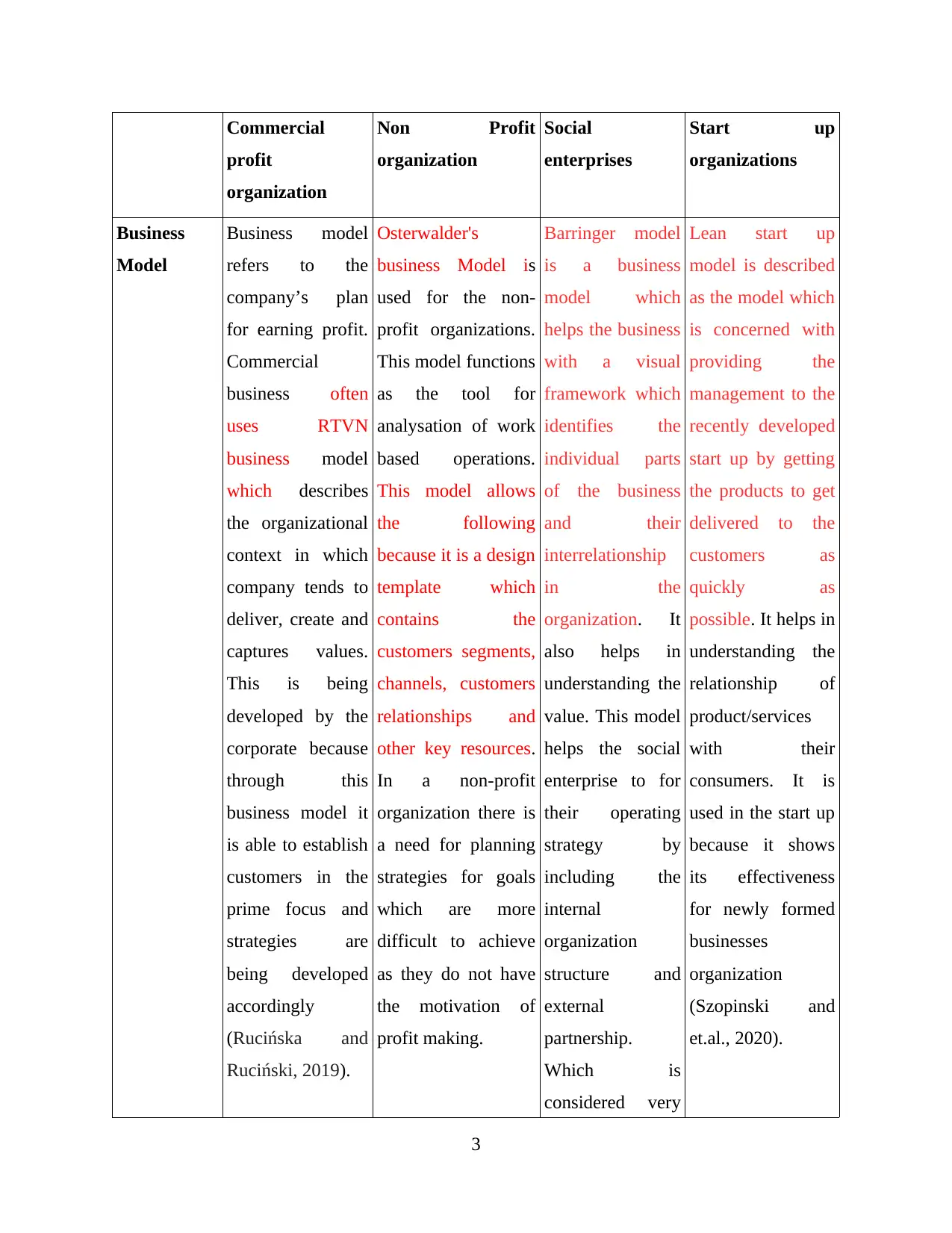
Commercial
profit
organization
Non Profit
organization
Social
enterprises
Start up
organizations
Business
Model
Business model
refers to the
company’s plan
for earning profit.
Commercial
business often
uses RTVN
business model
which describes
the organizational
context in which
company tends to
deliver, create and
captures values.
This is being
developed by the
corporate because
through this
business model it
is able to establish
customers in the
prime focus and
strategies are
being developed
accordingly
(Rucińska and
Ruciński, 2019).
Osterwalder's
business Model is
used for the non-
profit organizations.
This model functions
as the tool for
analysation of work
based operations.
This model allows
the following
because it is a design
template which
contains the
customers segments,
channels, customers
relationships and
other key resources.
In a non-profit
organization there is
a need for planning
strategies for goals
which are more
difficult to achieve
as they do not have
the motivation of
profit making.
Barringer model
is a business
model which
helps the business
with a visual
framework which
identifies the
individual parts
of the business
and their
interrelationship
in the
organization. It
also helps in
understanding the
value. This model
helps the social
enterprise to for
their operating
strategy by
including the
internal
organization
structure and
external
partnership.
Which is
considered very
Lean start up
model is described
as the model which
is concerned with
providing the
management to the
recently developed
start up by getting
the products to get
delivered to the
customers as
quickly as
possible. It helps in
understanding the
relationship of
product/services
with their
consumers. It is
used in the start up
because it shows
its effectiveness
for newly formed
businesses
organization
(Szopinski and
et.al., 2020).
3
profit
organization
Non Profit
organization
Social
enterprises
Start up
organizations
Business
Model
Business model
refers to the
company’s plan
for earning profit.
Commercial
business often
uses RTVN
business model
which describes
the organizational
context in which
company tends to
deliver, create and
captures values.
This is being
developed by the
corporate because
through this
business model it
is able to establish
customers in the
prime focus and
strategies are
being developed
accordingly
(Rucińska and
Ruciński, 2019).
Osterwalder's
business Model is
used for the non-
profit organizations.
This model functions
as the tool for
analysation of work
based operations.
This model allows
the following
because it is a design
template which
contains the
customers segments,
channels, customers
relationships and
other key resources.
In a non-profit
organization there is
a need for planning
strategies for goals
which are more
difficult to achieve
as they do not have
the motivation of
profit making.
Barringer model
is a business
model which
helps the business
with a visual
framework which
identifies the
individual parts
of the business
and their
interrelationship
in the
organization. It
also helps in
understanding the
value. This model
helps the social
enterprise to for
their operating
strategy by
including the
internal
organization
structure and
external
partnership.
Which is
considered very
Lean start up
model is described
as the model which
is concerned with
providing the
management to the
recently developed
start up by getting
the products to get
delivered to the
customers as
quickly as
possible. It helps in
understanding the
relationship of
product/services
with their
consumers. It is
used in the start up
because it shows
its effectiveness
for newly formed
businesses
organization
(Szopinski and
et.al., 2020).
3
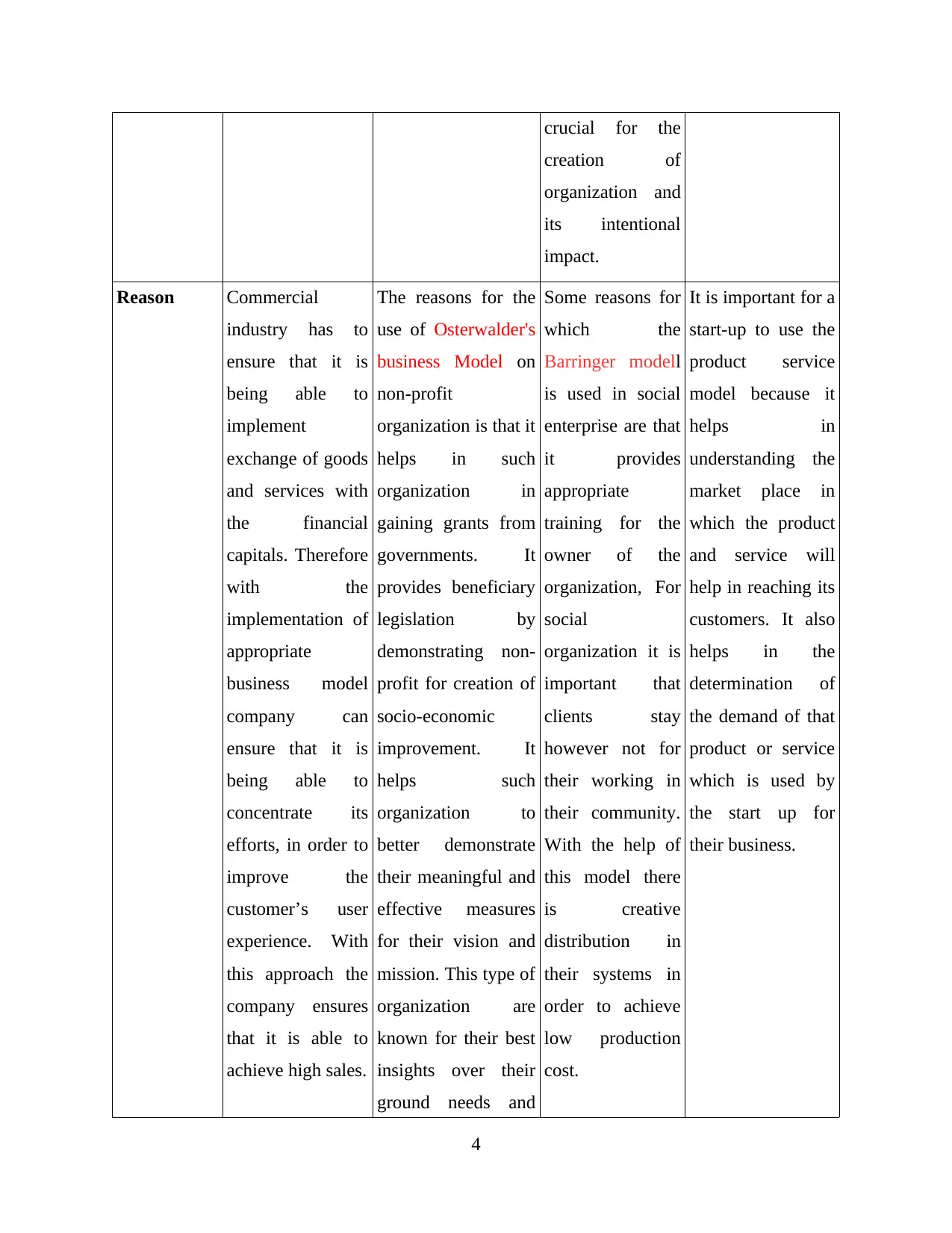
crucial for the
creation of
organization and
its intentional
impact.
Reason Commercial
industry has to
ensure that it is
being able to
implement
exchange of goods
and services with
the financial
capitals. Therefore
with the
implementation of
appropriate
business model
company can
ensure that it is
being able to
concentrate its
efforts, in order to
improve the
customer’s user
experience. With
this approach the
company ensures
that it is able to
achieve high sales.
The reasons for the
use of Osterwalder's
business Model on
non-profit
organization is that it
helps in such
organization in
gaining grants from
governments. It
provides beneficiary
legislation by
demonstrating non-
profit for creation of
socio-economic
improvement. It
helps such
organization to
better demonstrate
their meaningful and
effective measures
for their vision and
mission. This type of
organization are
known for their best
insights over their
ground needs and
Some reasons for
which the
Barringer modell
is used in social
enterprise are that
it provides
appropriate
training for the
owner of the
organization, For
social
organization it is
important that
clients stay
however not for
their working in
their community.
With the help of
this model there
is creative
distribution in
their systems in
order to achieve
low production
cost.
It is important for a
start-up to use the
product service
model because it
helps in
understanding the
market place in
which the product
and service will
help in reaching its
customers. It also
helps in the
determination of
the demand of that
product or service
which is used by
the start up for
their business.
4
creation of
organization and
its intentional
impact.
Reason Commercial
industry has to
ensure that it is
being able to
implement
exchange of goods
and services with
the financial
capitals. Therefore
with the
implementation of
appropriate
business model
company can
ensure that it is
being able to
concentrate its
efforts, in order to
improve the
customer’s user
experience. With
this approach the
company ensures
that it is able to
achieve high sales.
The reasons for the
use of Osterwalder's
business Model on
non-profit
organization is that it
helps in such
organization in
gaining grants from
governments. It
provides beneficiary
legislation by
demonstrating non-
profit for creation of
socio-economic
improvement. It
helps such
organization to
better demonstrate
their meaningful and
effective measures
for their vision and
mission. This type of
organization are
known for their best
insights over their
ground needs and
Some reasons for
which the
Barringer modell
is used in social
enterprise are that
it provides
appropriate
training for the
owner of the
organization, For
social
organization it is
important that
clients stay
however not for
their working in
their community.
With the help of
this model there
is creative
distribution in
their systems in
order to achieve
low production
cost.
It is important for a
start-up to use the
product service
model because it
helps in
understanding the
market place in
which the product
and service will
help in reaching its
customers. It also
helps in the
determination of
the demand of that
product or service
which is used by
the start up for
their business.
4
Secure Best Marks with AI Grader
Need help grading? Try our AI Grader for instant feedback on your assignments.
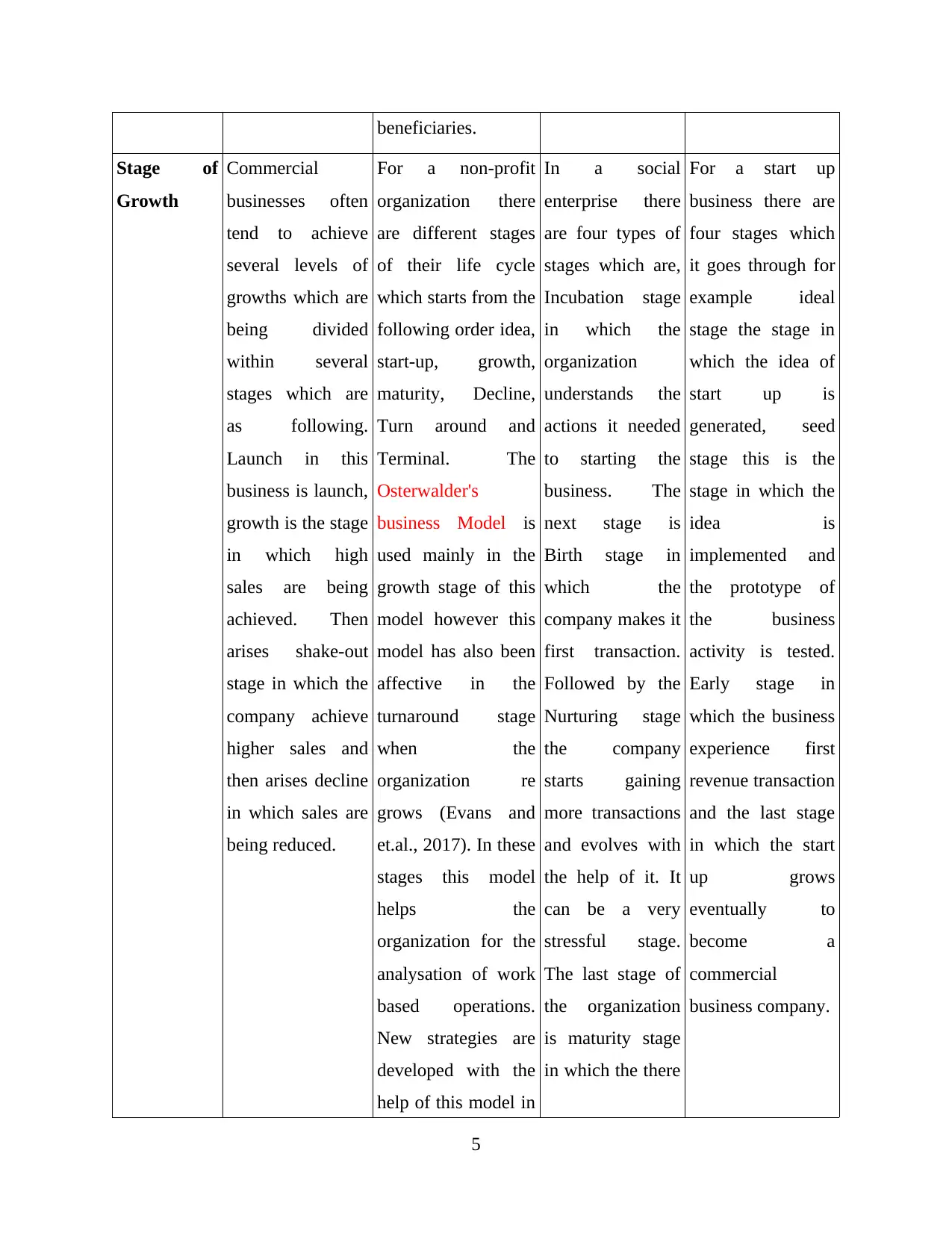
beneficiaries.
Stage of
Growth
Commercial
businesses often
tend to achieve
several levels of
growths which are
being divided
within several
stages which are
as following.
Launch in this
business is launch,
growth is the stage
in which high
sales are being
achieved. Then
arises shake-out
stage in which the
company achieve
higher sales and
then arises decline
in which sales are
being reduced.
For a non-profit
organization there
are different stages
of their life cycle
which starts from the
following order idea,
start-up, growth,
maturity, Decline,
Turn around and
Terminal. The
Osterwalder's
business Model is
used mainly in the
growth stage of this
model however this
model has also been
affective in the
turnaround stage
when the
organization re
grows (Evans and
et.al., 2017). In these
stages this model
helps the
organization for the
analysation of work
based operations.
New strategies are
developed with the
help of this model in
In a social
enterprise there
are four types of
stages which are,
Incubation stage
in which the
organization
understands the
actions it needed
to starting the
business. The
next stage is
Birth stage in
which the
company makes it
first transaction.
Followed by the
Nurturing stage
the company
starts gaining
more transactions
and evolves with
the help of it. It
can be a very
stressful stage.
The last stage of
the organization
is maturity stage
in which the there
For a start up
business there are
four stages which
it goes through for
example ideal
stage the stage in
which the idea of
start up is
generated, seed
stage this is the
stage in which the
idea is
implemented and
the prototype of
the business
activity is tested.
Early stage in
which the business
experience first
revenue transaction
and the last stage
in which the start
up grows
eventually to
become a
commercial
business company.
5
Stage of
Growth
Commercial
businesses often
tend to achieve
several levels of
growths which are
being divided
within several
stages which are
as following.
Launch in this
business is launch,
growth is the stage
in which high
sales are being
achieved. Then
arises shake-out
stage in which the
company achieve
higher sales and
then arises decline
in which sales are
being reduced.
For a non-profit
organization there
are different stages
of their life cycle
which starts from the
following order idea,
start-up, growth,
maturity, Decline,
Turn around and
Terminal. The
Osterwalder's
business Model is
used mainly in the
growth stage of this
model however this
model has also been
affective in the
turnaround stage
when the
organization re
grows (Evans and
et.al., 2017). In these
stages this model
helps the
organization for the
analysation of work
based operations.
New strategies are
developed with the
help of this model in
In a social
enterprise there
are four types of
stages which are,
Incubation stage
in which the
organization
understands the
actions it needed
to starting the
business. The
next stage is
Birth stage in
which the
company makes it
first transaction.
Followed by the
Nurturing stage
the company
starts gaining
more transactions
and evolves with
the help of it. It
can be a very
stressful stage.
The last stage of
the organization
is maturity stage
in which the there
For a start up
business there are
four stages which
it goes through for
example ideal
stage the stage in
which the idea of
start up is
generated, seed
stage this is the
stage in which the
idea is
implemented and
the prototype of
the business
activity is tested.
Early stage in
which the business
experience first
revenue transaction
and the last stage
in which the start
up grows
eventually to
become a
commercial
business company.
5
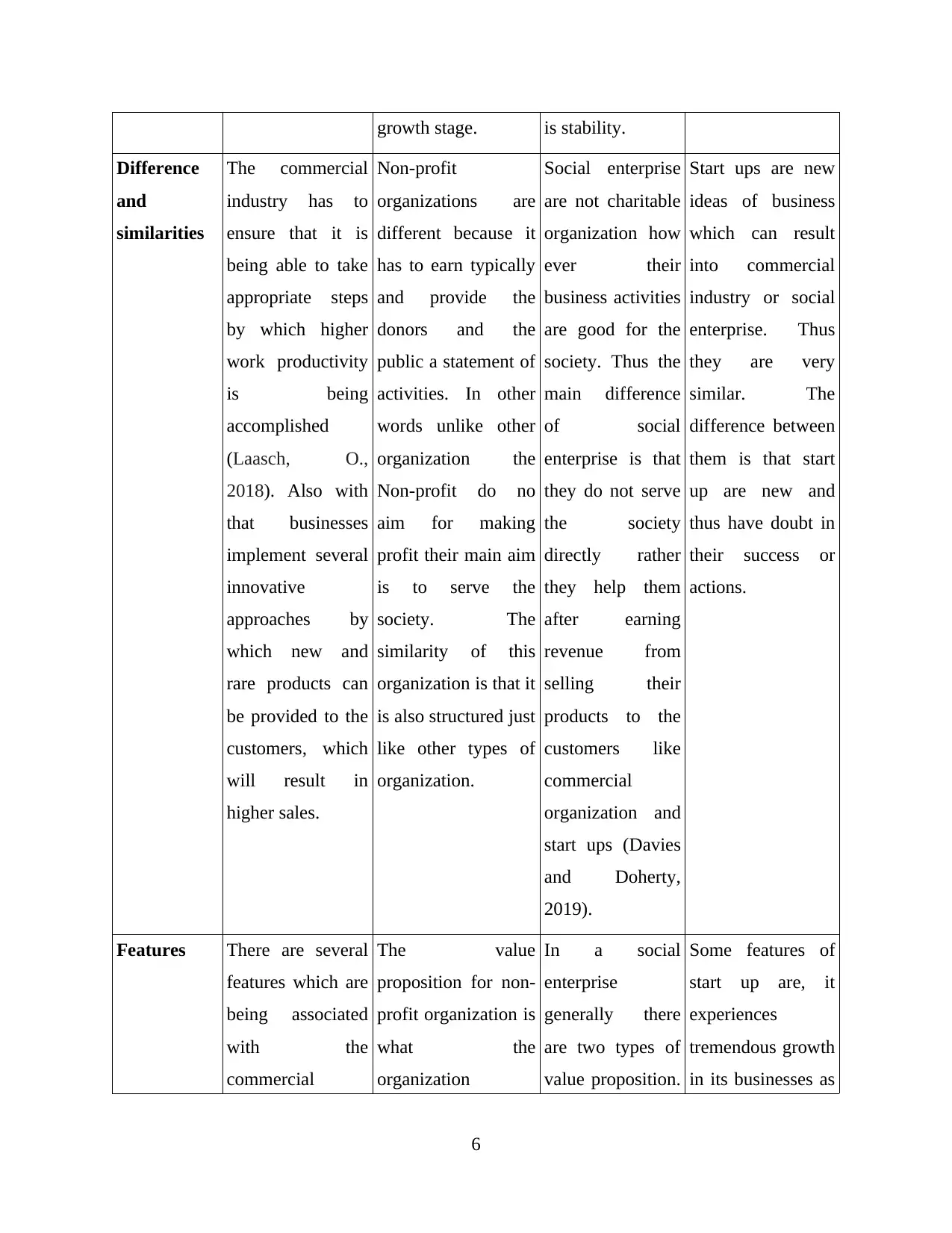
growth stage. is stability.
Difference
and
similarities
The commercial
industry has to
ensure that it is
being able to take
appropriate steps
by which higher
work productivity
is being
accomplished
(Laasch, O.,
2018). Also with
that businesses
implement several
innovative
approaches by
which new and
rare products can
be provided to the
customers, which
will result in
higher sales.
Non-profit
organizations are
different because it
has to earn typically
and provide the
donors and the
public a statement of
activities. In other
words unlike other
organization the
Non-profit do no
aim for making
profit their main aim
is to serve the
society. The
similarity of this
organization is that it
is also structured just
like other types of
organization.
Social enterprise
are not charitable
organization how
ever their
business activities
are good for the
society. Thus the
main difference
of social
enterprise is that
they do not serve
the society
directly rather
they help them
after earning
revenue from
selling their
products to the
customers like
commercial
organization and
start ups (Davies
and Doherty,
2019).
Start ups are new
ideas of business
which can result
into commercial
industry or social
enterprise. Thus
they are very
similar. The
difference between
them is that start
up are new and
thus have doubt in
their success or
actions.
Features There are several
features which are
being associated
with the
commercial
The value
proposition for non-
profit organization is
what the
organization
In a social
enterprise
generally there
are two types of
value proposition.
Some features of
start up are, it
experiences
tremendous growth
in its businesses as
6
Difference
and
similarities
The commercial
industry has to
ensure that it is
being able to take
appropriate steps
by which higher
work productivity
is being
accomplished
(Laasch, O.,
2018). Also with
that businesses
implement several
innovative
approaches by
which new and
rare products can
be provided to the
customers, which
will result in
higher sales.
Non-profit
organizations are
different because it
has to earn typically
and provide the
donors and the
public a statement of
activities. In other
words unlike other
organization the
Non-profit do no
aim for making
profit their main aim
is to serve the
society. The
similarity of this
organization is that it
is also structured just
like other types of
organization.
Social enterprise
are not charitable
organization how
ever their
business activities
are good for the
society. Thus the
main difference
of social
enterprise is that
they do not serve
the society
directly rather
they help them
after earning
revenue from
selling their
products to the
customers like
commercial
organization and
start ups (Davies
and Doherty,
2019).
Start ups are new
ideas of business
which can result
into commercial
industry or social
enterprise. Thus
they are very
similar. The
difference between
them is that start
up are new and
thus have doubt in
their success or
actions.
Features There are several
features which are
being associated
with the
commercial
The value
proposition for non-
profit organization is
what the
organization
In a social
enterprise
generally there
are two types of
value proposition.
Some features of
start up are, it
experiences
tremendous growth
in its businesses as
6
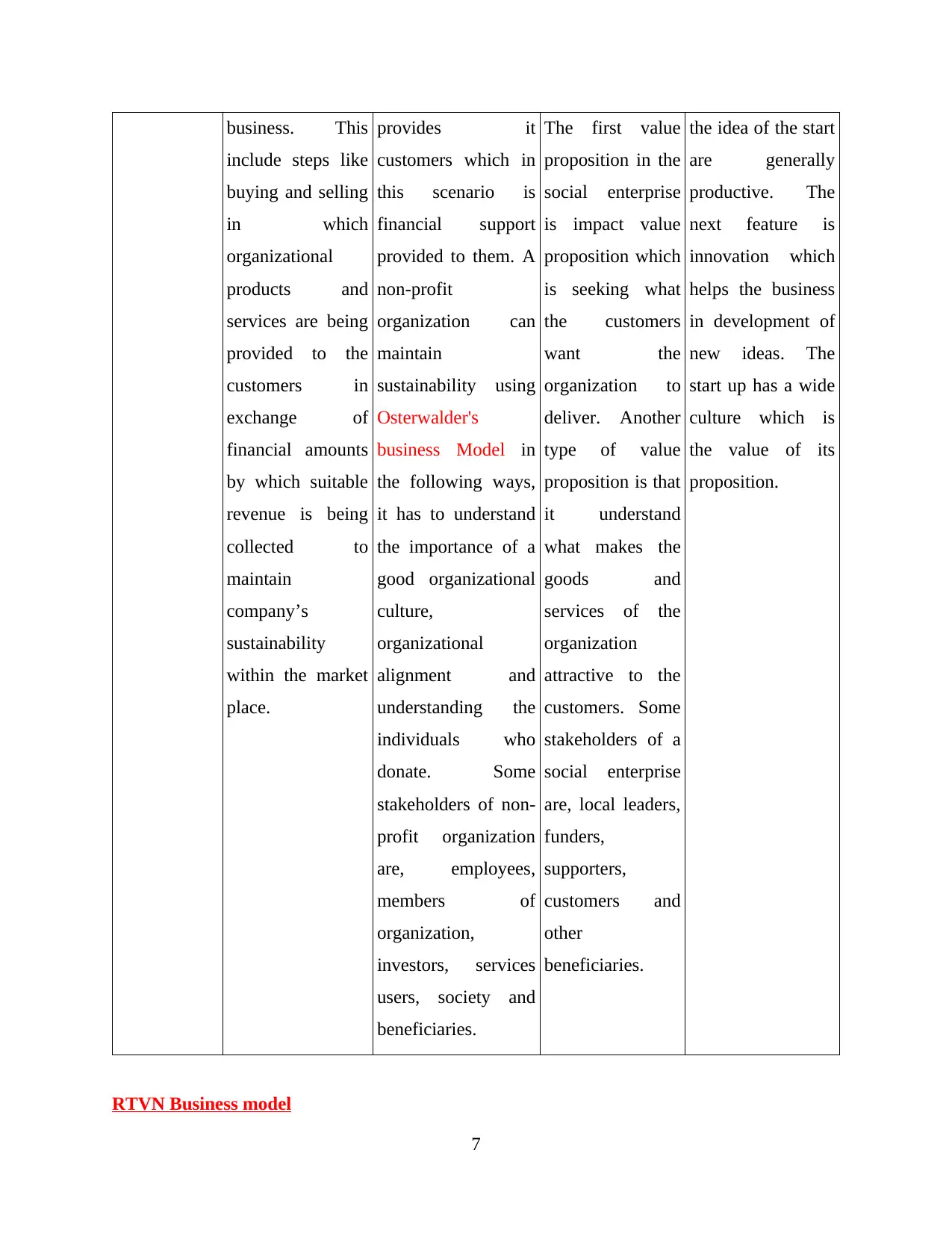
business. This
include steps like
buying and selling
in which
organizational
products and
services are being
provided to the
customers in
exchange of
financial amounts
by which suitable
revenue is being
collected to
maintain
company’s
sustainability
within the market
place.
provides it
customers which in
this scenario is
financial support
provided to them. A
non-profit
organization can
maintain
sustainability using
Osterwalder's
business Model in
the following ways,
it has to understand
the importance of a
good organizational
culture,
organizational
alignment and
understanding the
individuals who
donate. Some
stakeholders of non-
profit organization
are, employees,
members of
organization,
investors, services
users, society and
beneficiaries.
The first value
proposition in the
social enterprise
is impact value
proposition which
is seeking what
the customers
want the
organization to
deliver. Another
type of value
proposition is that
it understand
what makes the
goods and
services of the
organization
attractive to the
customers. Some
stakeholders of a
social enterprise
are, local leaders,
funders,
supporters,
customers and
other
beneficiaries.
the idea of the start
are generally
productive. The
next feature is
innovation which
helps the business
in development of
new ideas. The
start up has a wide
culture which is
the value of its
proposition.
RTVN Business model
7
include steps like
buying and selling
in which
organizational
products and
services are being
provided to the
customers in
exchange of
financial amounts
by which suitable
revenue is being
collected to
maintain
company’s
sustainability
within the market
place.
provides it
customers which in
this scenario is
financial support
provided to them. A
non-profit
organization can
maintain
sustainability using
Osterwalder's
business Model in
the following ways,
it has to understand
the importance of a
good organizational
culture,
organizational
alignment and
understanding the
individuals who
donate. Some
stakeholders of non-
profit organization
are, employees,
members of
organization,
investors, services
users, society and
beneficiaries.
The first value
proposition in the
social enterprise
is impact value
proposition which
is seeking what
the customers
want the
organization to
deliver. Another
type of value
proposition is that
it understand
what makes the
goods and
services of the
organization
attractive to the
customers. Some
stakeholders of a
social enterprise
are, local leaders,
funders,
supporters,
customers and
other
beneficiaries.
the idea of the start
are generally
productive. The
next feature is
innovation which
helps the business
in development of
new ideas. The
start up has a wide
culture which is
the value of its
proposition.
RTVN Business model
7
Paraphrase This Document
Need a fresh take? Get an instant paraphrase of this document with our AI Paraphraser
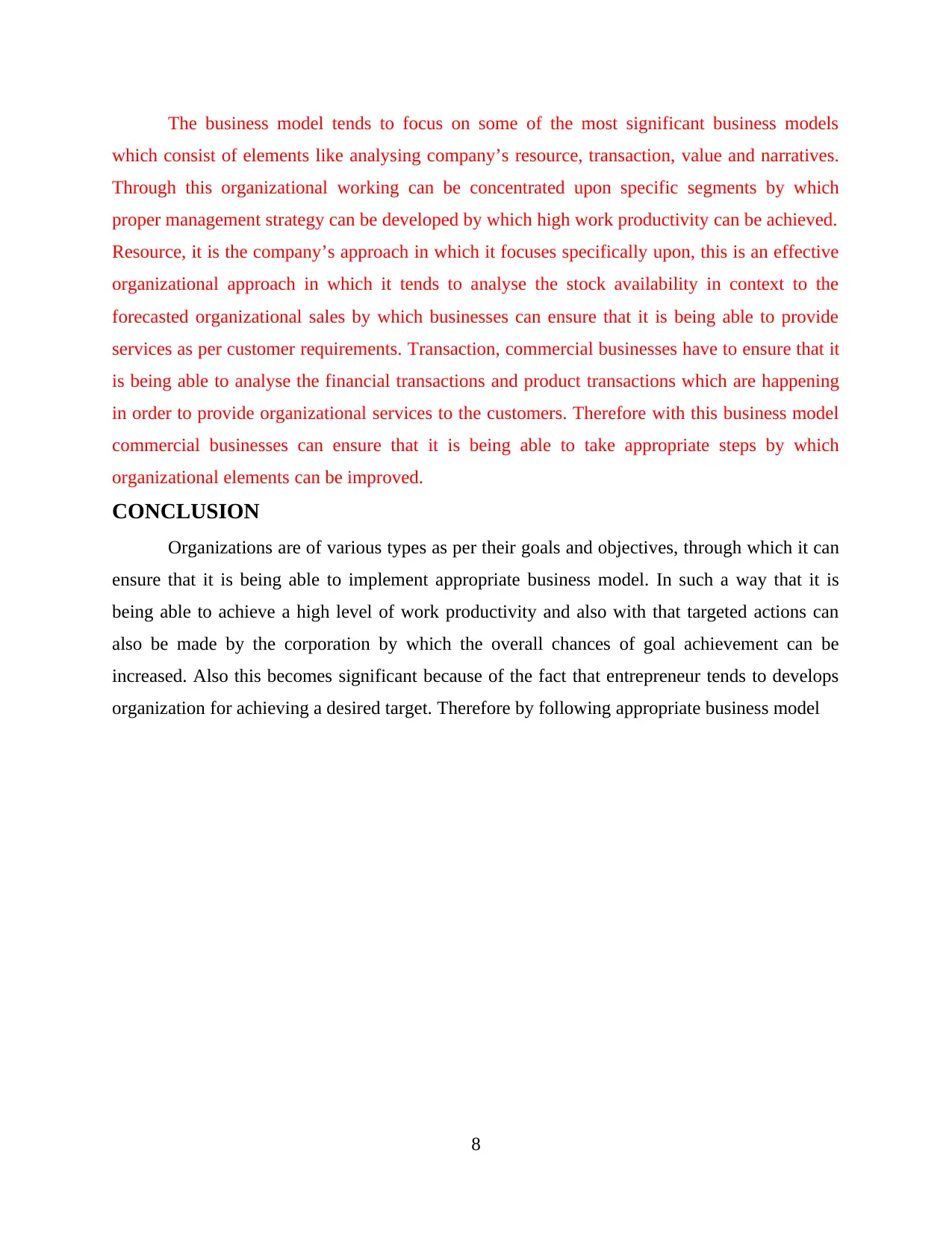
The business model tends to focus on some of the most significant business models
which consist of elements like analysing company’s resource, transaction, value and narratives.
Through this organizational working can be concentrated upon specific segments by which
proper management strategy can be developed by which high work productivity can be achieved.
Resource, it is the company’s approach in which it focuses specifically upon, this is an effective
organizational approach in which it tends to analyse the stock availability in context to the
forecasted organizational sales by which businesses can ensure that it is being able to provide
services as per customer requirements. Transaction, commercial businesses have to ensure that it
is being able to analyse the financial transactions and product transactions which are happening
in order to provide organizational services to the customers. Therefore with this business model
commercial businesses can ensure that it is being able to take appropriate steps by which
organizational elements can be improved.
CONCLUSION
Organizations are of various types as per their goals and objectives, through which it can
ensure that it is being able to implement appropriate business model. In such a way that it is
being able to achieve a high level of work productivity and also with that targeted actions can
also be made by the corporation by which the overall chances of goal achievement can be
increased. Also this becomes significant because of the fact that entrepreneur tends to develops
organization for achieving a desired target. Therefore by following appropriate business model
8
which consist of elements like analysing company’s resource, transaction, value and narratives.
Through this organizational working can be concentrated upon specific segments by which
proper management strategy can be developed by which high work productivity can be achieved.
Resource, it is the company’s approach in which it focuses specifically upon, this is an effective
organizational approach in which it tends to analyse the stock availability in context to the
forecasted organizational sales by which businesses can ensure that it is being able to provide
services as per customer requirements. Transaction, commercial businesses have to ensure that it
is being able to analyse the financial transactions and product transactions which are happening
in order to provide organizational services to the customers. Therefore with this business model
commercial businesses can ensure that it is being able to take appropriate steps by which
organizational elements can be improved.
CONCLUSION
Organizations are of various types as per their goals and objectives, through which it can
ensure that it is being able to implement appropriate business model. In such a way that it is
being able to achieve a high level of work productivity and also with that targeted actions can
also be made by the corporation by which the overall chances of goal achievement can be
increased. Also this becomes significant because of the fact that entrepreneur tends to develops
organization for achieving a desired target. Therefore by following appropriate business model
8
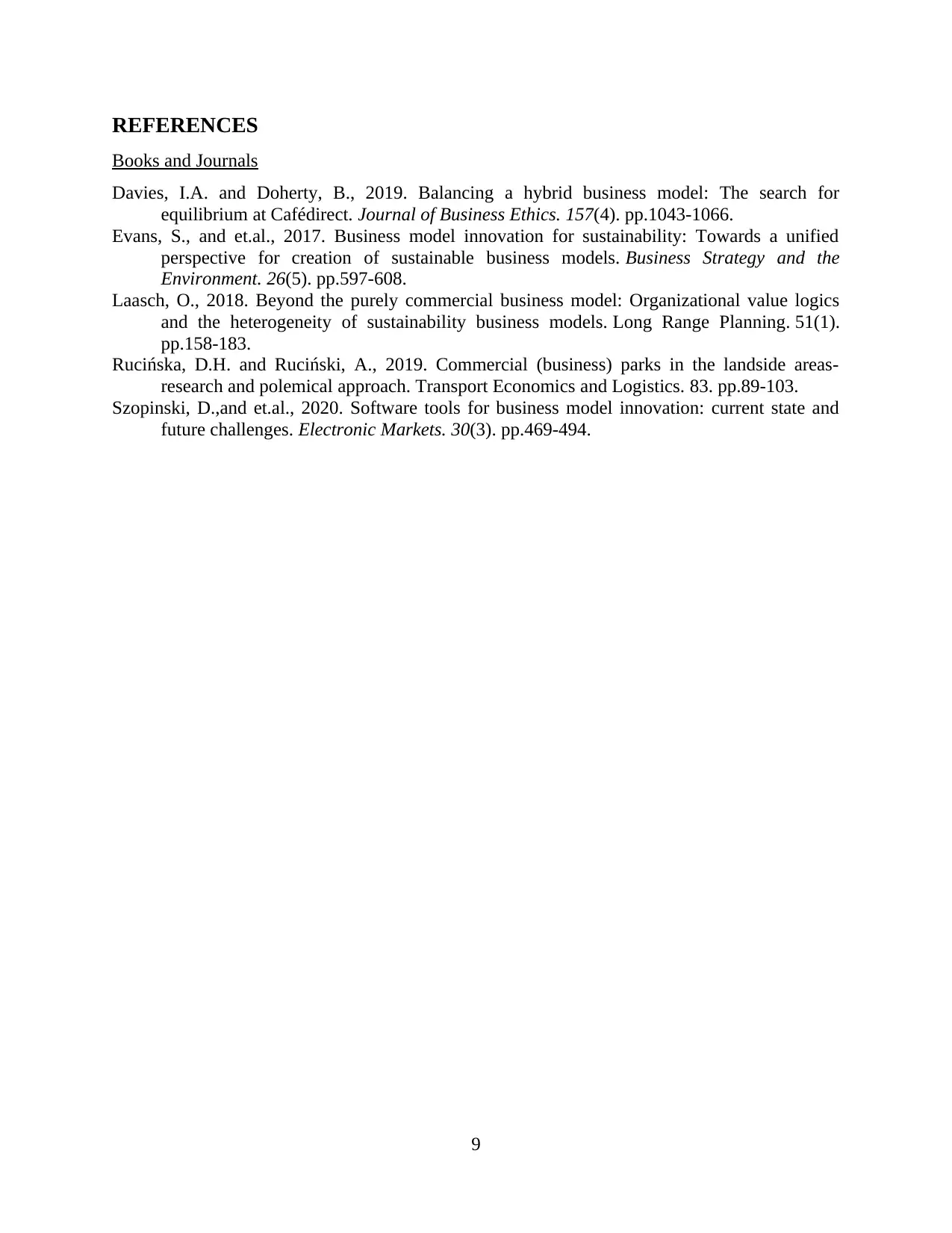
REFERENCES
Books and Journals
Davies, I.A. and Doherty, B., 2019. Balancing a hybrid business model: The search for
equilibrium at Cafédirect. Journal of Business Ethics. 157(4). pp.1043-1066.
Evans, S., and et.al., 2017. Business model innovation for sustainability: Towards a unified
perspective for creation of sustainable business models. Business Strategy and the
Environment. 26(5). pp.597-608.
Laasch, O., 2018. Beyond the purely commercial business model: Organizational value logics
and the heterogeneity of sustainability business models. Long Range Planning. 51(1).
pp.158-183.
Rucińska, D.H. and Ruciński, A., 2019. Commercial (business) parks in the landside areas-
research and polemical approach. Transport Economics and Logistics. 83. pp.89-103.
Szopinski, D.,and et.al., 2020. Software tools for business model innovation: current state and
future challenges. Electronic Markets. 30(3). pp.469-494.
9
Books and Journals
Davies, I.A. and Doherty, B., 2019. Balancing a hybrid business model: The search for
equilibrium at Cafédirect. Journal of Business Ethics. 157(4). pp.1043-1066.
Evans, S., and et.al., 2017. Business model innovation for sustainability: Towards a unified
perspective for creation of sustainable business models. Business Strategy and the
Environment. 26(5). pp.597-608.
Laasch, O., 2018. Beyond the purely commercial business model: Organizational value logics
and the heterogeneity of sustainability business models. Long Range Planning. 51(1).
pp.158-183.
Rucińska, D.H. and Ruciński, A., 2019. Commercial (business) parks in the landside areas-
research and polemical approach. Transport Economics and Logistics. 83. pp.89-103.
Szopinski, D.,and et.al., 2020. Software tools for business model innovation: current state and
future challenges. Electronic Markets. 30(3). pp.469-494.
9
1 out of 9
Related Documents
Your All-in-One AI-Powered Toolkit for Academic Success.
+13062052269
info@desklib.com
Available 24*7 on WhatsApp / Email
![[object Object]](/_next/static/media/star-bottom.7253800d.svg)
Unlock your academic potential
© 2024 | Zucol Services PVT LTD | All rights reserved.





